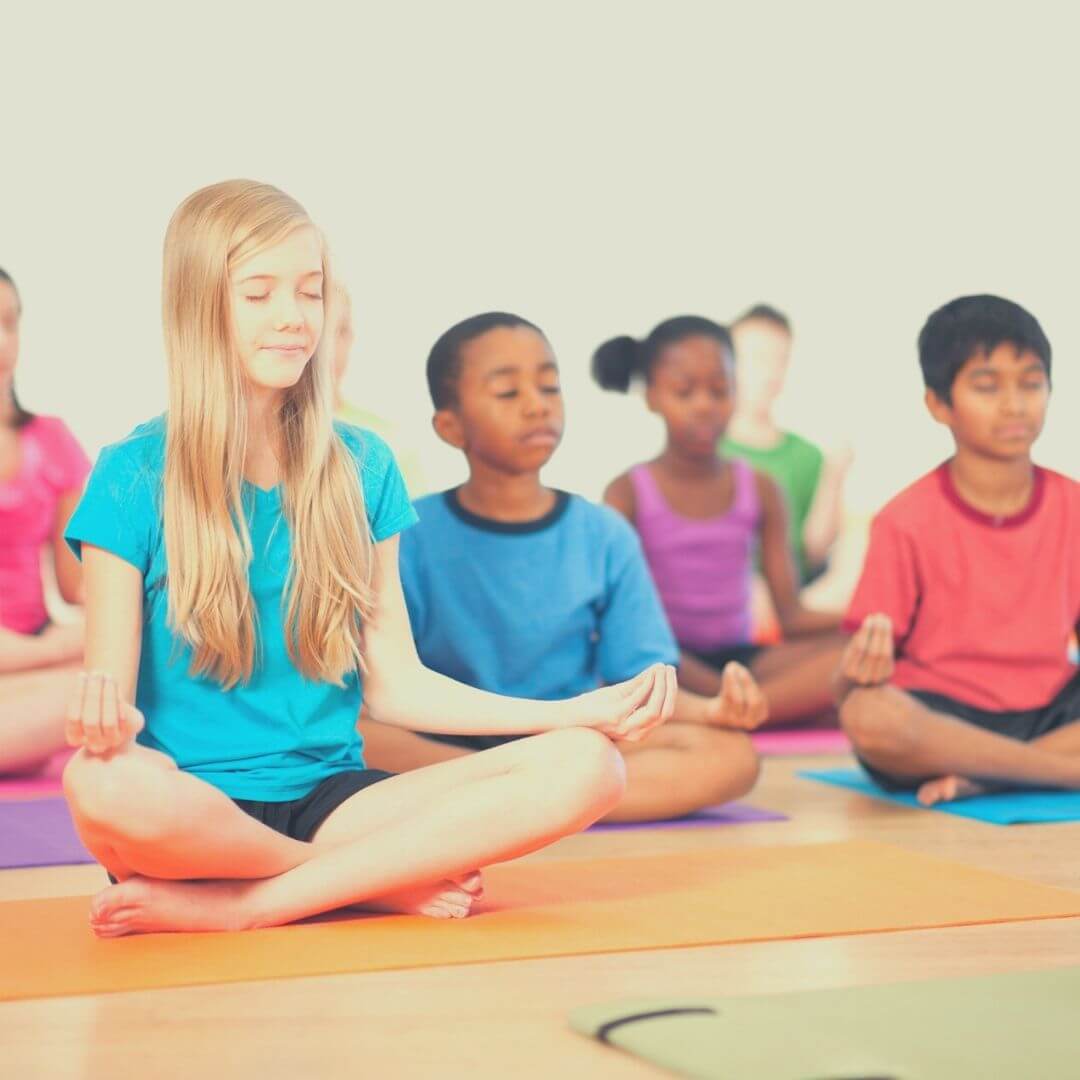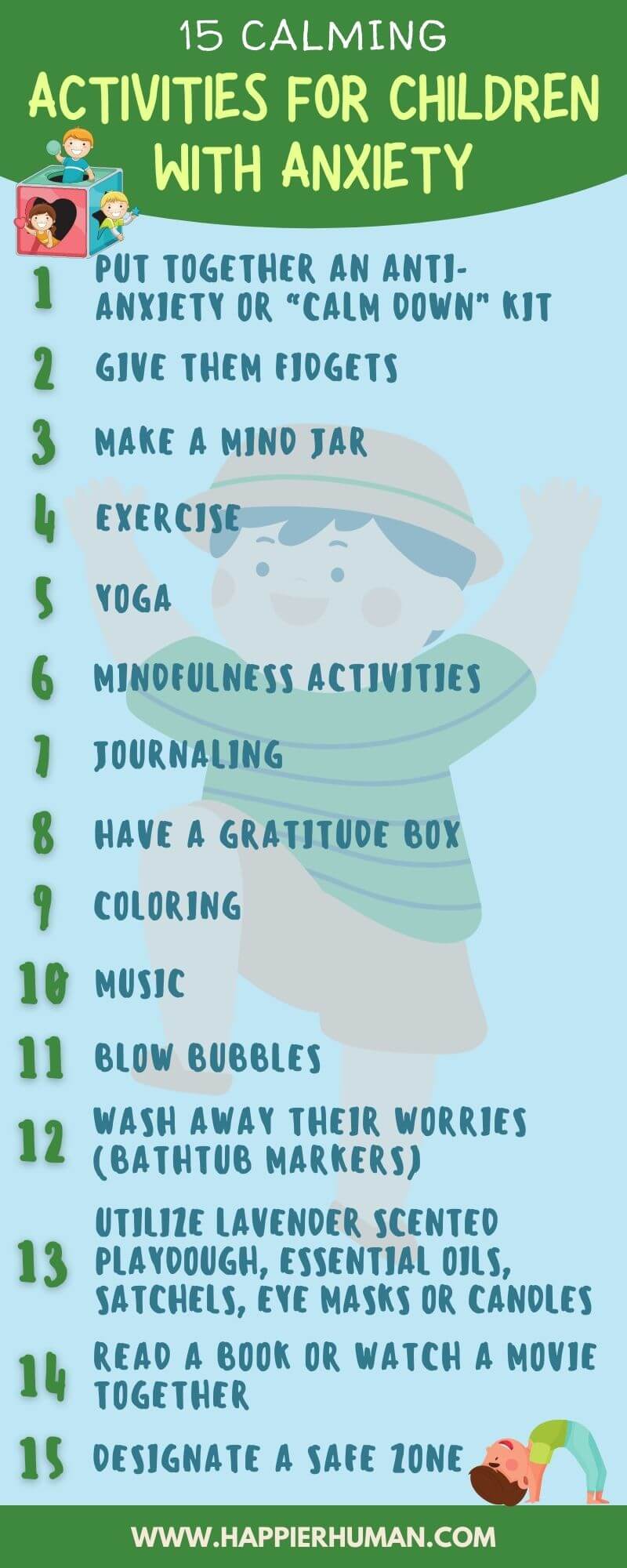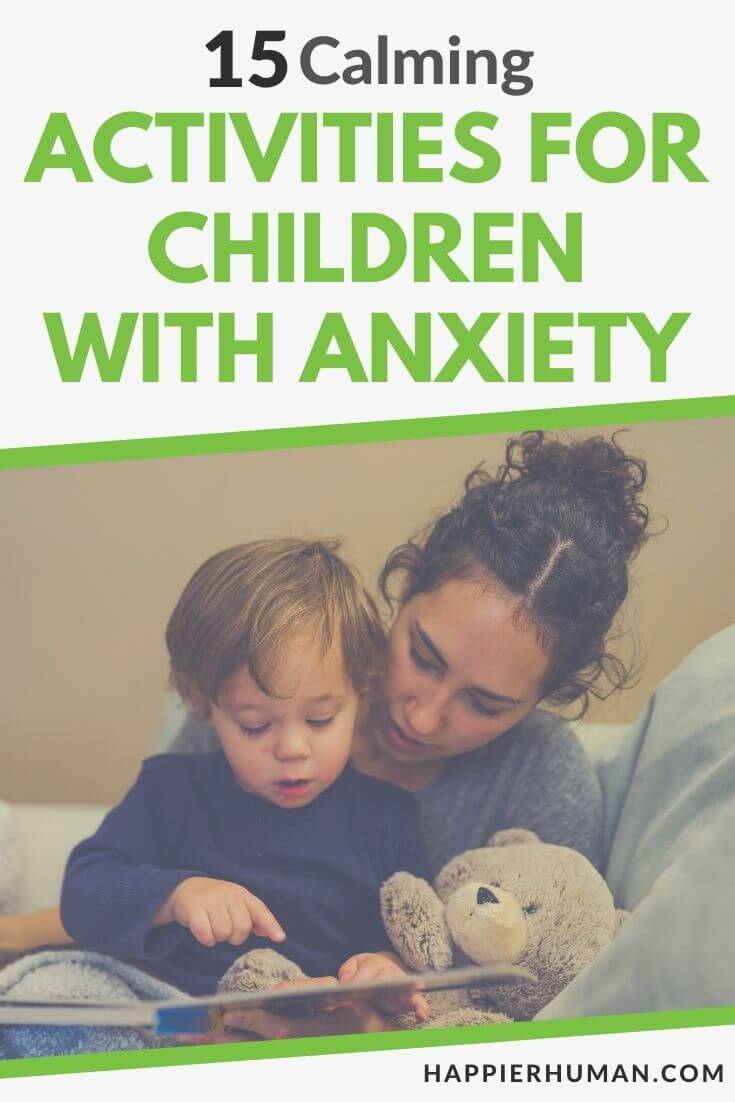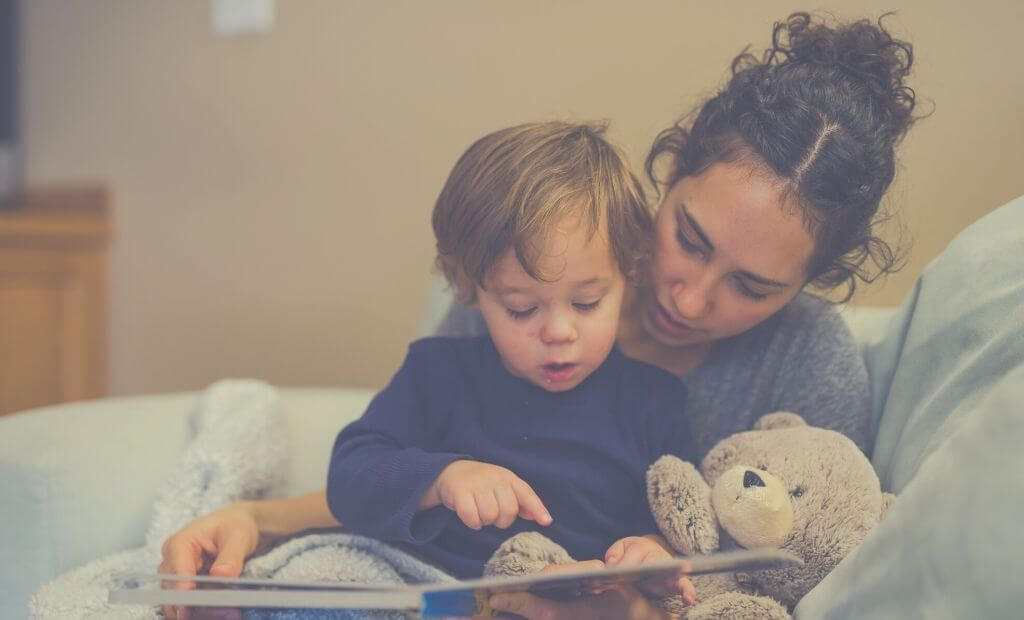Does your child seem nervous, sad, angry or withdrawn at times?
Does he cry at the drop of a hat or still have issues with wetting the bed?
Does his self-esteem seem low, despite all of the compliments you give him on a regular basis?
These are just some of the ways anxiety presents itself in children.
Anxiety can take a toll on a person’s mental and physical well-being if it’s not addressed… especially in children. The sooner you establish a plan to face their anxieties and work through them, the greater chance you have of them leading normal lives as they grow older.
While a clinical diagnosis and therapy can be helpful in battling anxiety… as a parent, you just know something is “off”.
Trust your instincts. There are steps you can take before seeking professional help, or in conjunction with it, that will get your child started on a path to healing.
In this article, we’ll offer some very good (and fun) activities for children with anxiety that parents, teachers and caregivers can do with them to help ease their woes.
What Causes Anxiety in Children?
All of us were born with a “fight or flight” instinct. It started out in the most primal way, when humans first walked the earth and literally had to protect themselves against their worst fears to ward off death… be it a physical attack, harsh weather and living conditions or mental fatigue.
This instinct has evolved over time, now referring to the way many of us handle difficult situations or emotions.
If we are lucky, we can choose to let the fear in and face it head on with little damage to our psyche… but not everyone is able to do that, especially children who often don’t know what they are feeling or how to make sense of it.
There are also certain factors at play when determining why some children are more prone to anxiety than others. These include:
Sadly, anxiety presents itself in many different ways… at times, making it hard to identify. For instance, if your child seems to be in her own world and spaces out quite often, your first thought may be Attention Deficit Disorder (or ADD). But did you know that is also a sign of anxiety?
There are emotional and physical ways in which anxiety can present itself. The most common are:
There are also different types of anxiety, which will likely require a clinical diagnosis to pinpoint. Generalized anxiety often presents itself in the ways outlined above; however, different fears or phobias may result in different types of reactions from your child.
Separation anxiety is most common among younger children. Our first born son suffered from this and it was painful for us, as well as him. He refused to nap in full day pre-school and cried for hours at a time, often sitting with the teacher until we picked him up. It got to a point where we pulled him out and enrolled him in a 2-hour program.
At the same time, he would often walk around the house and just start banging his head into walls when he was upset… which, at times, seemed to come out of nowhere.
We were first time parents and didn’t want to or couldn’t acknowledge that something was wrong with our little prince.
But nearly 8 years later, we’ve realized those moments were the start of our son’s battle with anxiety… a battle we are still fighting together with help from our family, friends, teachers and others.
Phobias are fears that typically surface among school age children.
Social anxiety comes into playas kids enter their adolescent years. They will avoid any situation that makes them uncomfortable and tend to have very few friends, as they are always afraid of being judged.
Panic attacks most often develop in the later years, and can have serious physical implications on a child with anxiety.
It is always a good idea to consult with your child’s pediatrician if you are having concerns they may be suffering from some form of anxiety. Just be wary of medical professionals too quick to want to medicate your child.
Activities for children with anxiety can do wonders for their body and mind, especially if you make them seem fun. All of the ones we’ll talk about here are designed to keep your child engaged, while helping him develop coping skills he’ll use throughout his life.
15 Calming Activities for Children With Anxiety
1. Put together an anti-anxiety or “calm down” kit
You can buy a cool old-school metal lunch box, or decorate a shoebox… whatever floats your boat for this one. The important thing to focus on is what’s inside.
An anti-anxiety or calm down kit should include comfort objects that your child feels connected to. Things like:
It’s crucial that this box gives them an immediate sense of joy and peace. You may even find some of the other activities we’ll mention can be incorporated into the box.
2. Give them fidgets
Fidgets are sensory toys and gadgets, designed to engage kids and help them focus on a fairly mindless activity. It’s calming effects have also been noted among researchers. Fidget toys are quiet, so as to limit distraction… which also makes them great for the classroom.
The most popular fidget toys include spinners, stress balls, putty, bubble pop-its, stretch it fidget men. You can buy an assortment of gadgets like this one on Amazon.
3. Make a mind jar
When I think of a mind jar, I picture Dr. Frankenstein’s experiment… but that is not what we mean here. I promise.
A mind jar is something a child can hold and shake when they feel the need to calm down and take their mind off of what bothers them. They are quick and easy to make and, depending on your child’s age, can be made from glass or plastic.
Here’s what you need:
- A mason jar (or plastic apple sauce jug)
- Glitter Glue
- Food Coloring
- Hot Water (this is to melt the glue)
Some people even prefer to add marbles or a fun little gadget to the jar. You can be as creative as you want with your mind jar, just be sure to make it a color your child finds calming.
For step by step instructions, check out this YouTube video.
4. Exercise
We all know that exercise is good for the body, but it can also do wonders to relieve stress… which makes it one of the choice activities for children with anxiety.
If the weather is nice… go for a walk, hike, bike, swim or jog. If it’s indoor weather… activities like martial arts, kickboxing, dance, rock climbing and ninja courses are great ways to let go of aggression and calm the mind.
5. Yoga
We’ve all heard about the benefits of yoga for the body. The most noted being increased flexibility, muscle tone and core strength, improved energy and vitality, and cardiovascular and circulatory health.

But the effects on the mind are what can make it a perfect addition to an anxious child’s daily routine. The rhythmic breathing and quieting of the mind through meditation are wonderful ways to reduce stress almost immediately.
A quick online search can help you find the perfect videos to do at home. Younger kids like mine really enjoy Cosmic Kids Yoga, with a selection of videos available on YouTube.
6. Mindfulness activities
Mindfulness is a type of meditation that allows you to focus on being intensely aware of what you're sensing and feeling in the moment – without interpretation or judgment.
It typically involves paying attention to your breathing and guided imagery in order to relax the body and mind… and reduce stress.
Mindfulness activities for kids are practiced in many classrooms today, as teachers search for ways to redirect their students’ focus, as well as help them calm their nerves.
The video below shows more morning routine ideas that can help you and your kids become more mindful on a daily basis.
7. Journaling
Journaling is a wonderful way for us to express ourselves, no matter what age we are. There are many types of journals, among the most popular being the gratitude journal.
If your child is struggling with their emotions, encourage them to write in a journal. If they can’t write well, they can draw pictures to express how they are feeling.
You can find a wide selection of journals online or in bookstores… some you can even decorate together to make it more personalized.
8. Have a gratitude box
If your child is experiencing anxiety, it’s important for you to redirect their focus on the things and people in their life that they are grateful for.
Set aside a box, jar or plastic container (even a fishbowl would work) and encourage your child to write down on a piece of paper one thing they are most grateful for that day. When they are feeling especially down, make it a point to read through them all together.
9. Coloring
Coloring is one of the most relaxing activities for children with anxiety. It is mindless and helps fine motor skills develop in younger kids.
Coloring therapy can soothe and reduce anxiety by giving your child something simple, yet requiring complete focus to work on. The patterns and colors are hypnotic and simply make you feel better, more powerful and more in charge of yourself… all great things when you are dealing with anxiety.
Furthermore, artistic expression helps anxiety sufferers to go deeper into a relaxed state, which can make other forms of therapy more effective. Even adults have found calming benefits in coloring.
10. Music
Music is a great mood enhancer… be it lifting the spirits or letting out pent up emotion.
When your child is having a rough day, put together a playlist of your child’s favorite songs and play it for them. Dance! Sing! Laugh!
You can also form a band and have instruments for them to play. Banging on cymbals, drums, or playing guitar or the piano has proven to be extremely therapeutic for people suffering from depression or pent up anxiety.
11. Blow bubbles
While it may seem silly, blowing bubbles can quiet anxiety and negative thoughts in a short amount of time.
In fact, blowing bubbles forces people to stop what they are doing and focus on their breathing… which can help lower anxiety levels, experts say. It is also a good way to picture yourself physically moving anxiety away from you. Imagine the bubbles carrying your troubles away.
12. Wash away their worries (bathtub markers)
Our kids received bathtub markers for the holidays last year… and they were a big hit! It’s a great way for kids to express themselves in the tub, without leaving a big mess for you to clean up.
As an anxiety queller, washable bathtub markers are excellent for getting them to write down or draw what’s bothering them… and then washing those problems away as the water drains.
You may even want to recite a mantra or two of positive thoughts as the drain bleeds their anxieties.
13. Use lavender-scented products
Lavender is not only a beautiful scent, but proven to be calming.
Studies have shown that a primary benefit of lavender is that it can calm without sedation. More than simply generating a serene state of mind, lavender can reduce anxiety by affecting the body's fight-or-flight response.
Many companies offer lavender-scented products, safe for kids of all ages. Aroma-dough, a lavender playdough-esque toy, is great for stimulating a nervous child’s mind and body… as well as sparking creativity. And creativity leads to positive thinking and greater self esteem.
Eye masks are also a great option for anxious kids who have trouble sleeping. These are also essential oils, satchels, or candles.
14. Read a book or watch a movie together
We have family movie nights in our house 1-2 nights per week, where we pick from a predetermined list of our favorite movies (usually out of a hat or brown paper bag) and watch it. No arguments.

If you have one, or more, children who suffer from anxiety… you can try adding a few movies dealing with sensitive topics to the mix. Afterwards, be sure to leave time for discussion as a family, which can go a long way in making their feelings seem validated.
15. Designate a safe zone
When you have a child who seems to be agitated or anxious quite frequently, it may be a good idea to give them a place to call their own… for personal space.
A safe zone.
This is not to say you should not address your child’s issues head on, but sometimes giving them a bit of time and independence to work things out on their own is the best way to start a conversation when they are ready.
This place can be an entire room, a treehouse, a swing or shed. Even a closet can work.
As long as you both know it’s a place they can go to be alone with their emotions, the rest will figure itself out… and the healing can begin.
Final Thoughts on Calming Activities for Children with Anxiety
No two children are born the same. Not the way they look (even identical twins have the slightest distinguishing features), not the way they behave… and certainly not the way they react to life’s ups and downs.
A child can have anxiety the same way adults too, only theirs is often more confusing for them because they are not sure of what they are feeling or thinking at such a young age. They also rely heavily on the adults in their life to identify that they have an issue… and determine a proper course of action for dealing with it.
If your parental “spidey senses” are tingling and you feel something is “off” or wrong with your child… start doing your research. Ask for the opinions of other family members and their teachers. Try and get to the bottom of things and then work on incorporating the steps outlined here.
If the problem seems like it needs more help, seek a professional’s opinion sooner than later. As we mentioned earlier, the sooner you are able to help your child develop good emotional habits, the more likely they are to grow into well adjusted adults.
For more information on anxiety and how to prevent it from taking over your life, check out this article. Also, feel free to share your personal stories and tips in our comments section below.
And if you're looking for more resources, check out some more ideas to manage anxiety:
- 7 Highly Sensitive Child Parenting Strategies
- 45 Quick Mood Boosting Activities to Lift Your Spirits
- 15 Printable Coloring Pages for Anxiety Reduction
- 17 Best Gifts for People with Anxiety
- 15 Social Skills Activities to Help Your Kids Emotionally Develop

Nicole Krause has been writing both personally and professionally for over 20 years. She holds a dual B.A. in English and Film Studies. Her work has appeared in some of the country’s top publications, major news outlets, online publications and blogs. As a happily married (and extremely busy) mother of four… her articles primarily focus on parenting, marriage, family, finance, organization and product reviews.
Finally, if you want to level up your parenting skills, then check out this resource that will show you how to get your kids to listen WITHOUT yelling, nagging, or losing control.


